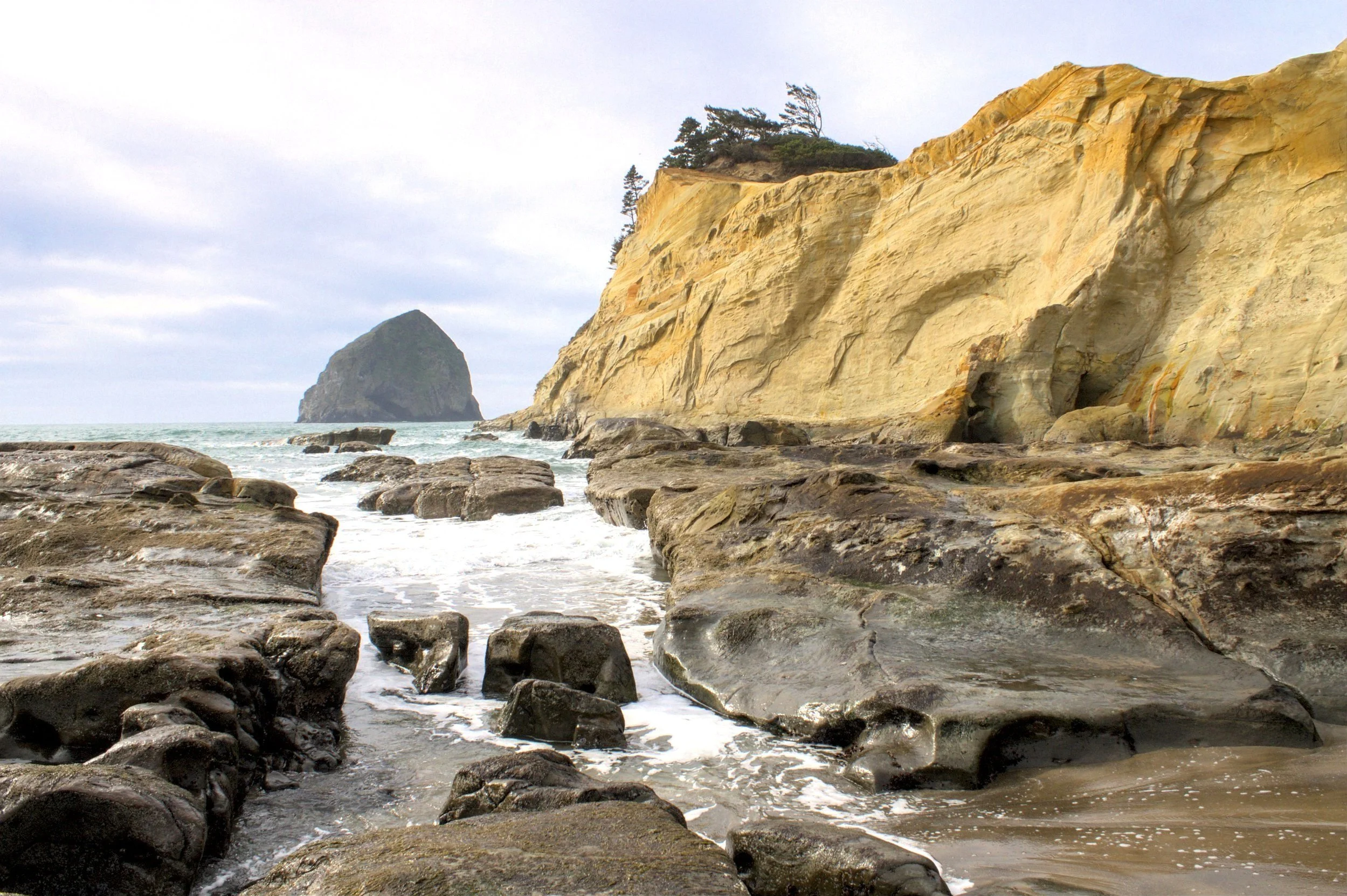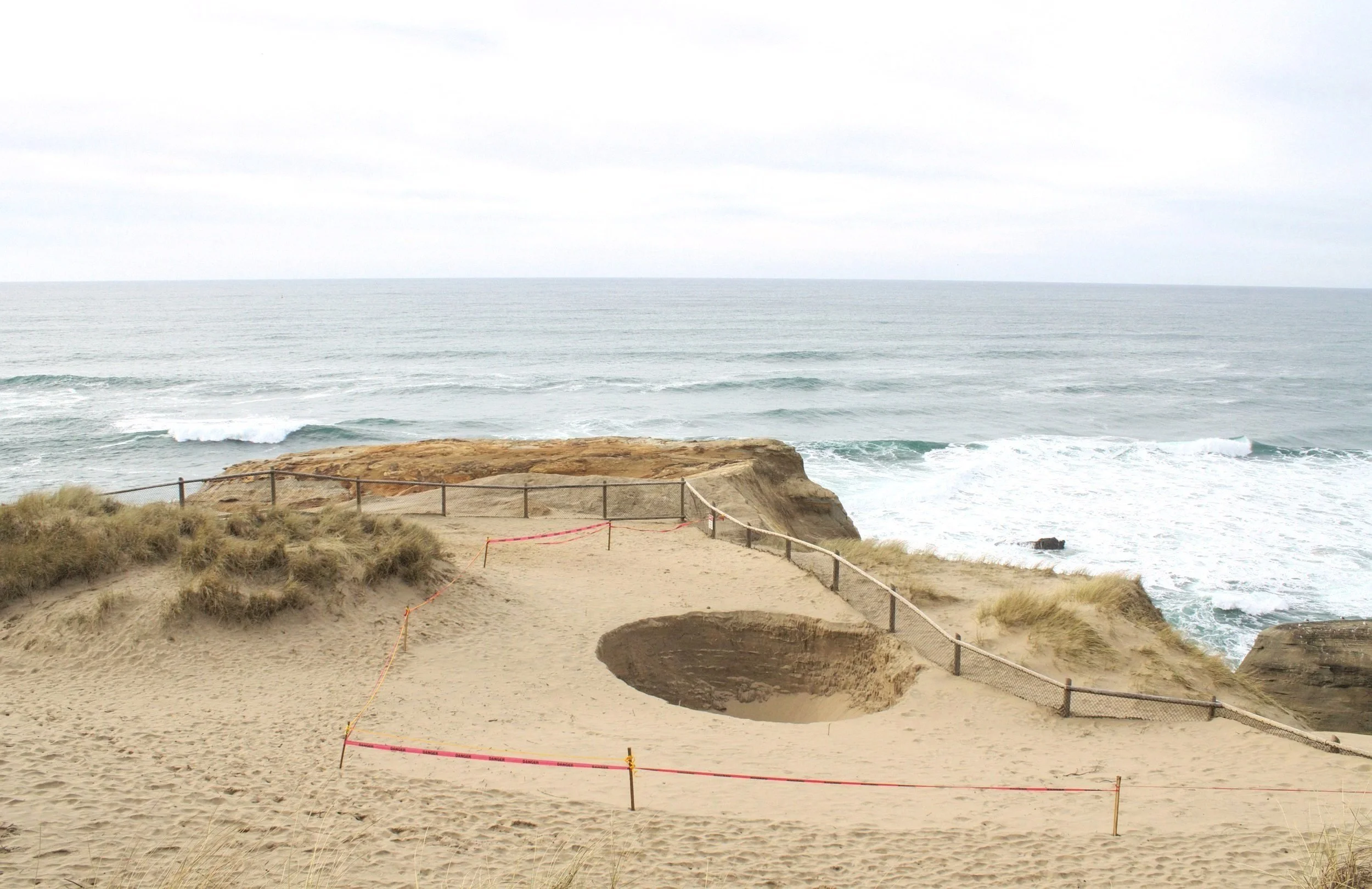Cape Kiwanda and Its Big Sinkhole
Haystack Rock and Cape Kiwanda
Pacific City’s Cape Kiwanda has rightly been called one of the most photogenic places in the country. Storms, waves, and wind have carved the sandstone cliffs here into fascinating shapes from caves to chasms. This fragile headland is also one of the most rapidly changing landscapes on the Oregon Coast, and its newest feature is a large and expanding sinkhole. Whether you’re interested in the beauty of the cliffs or the geological curiosity that is the sinkhole, Cape Kiwanda is a wonderful getaway. Here is everything you need to know about visiting.
Fences lead you through Cape Kiwanda
Know before you go
Parking at Cape Kiwanda is $10/day. This fee is specific to Tillamook County and no annual state or national recreation passes are accepted. There are pay stations in the parking lot that accept credit cards.
Cape Kiwanda is popular and the parking lot may fill up on summer weekends.
Leashed dogs are welcome at Cape Kiwanda.
There are restrooms at the east end of the parking lot.
The sandstone cliffs of Cape Kiwanda are fragile and prone to crumbling without warning. Waves near the cliffs can also be unpredictable. There are fences to guide you through the safe areas of the park. Do not explore beyond the fences. These areas are dangerous and people have died here.
The views from Cape Kiwanda are excellent regardless of the tide. There is a sandstone platform at the base of the cape that you can explore at low tide when the ocean is calm. You can find tidepools there.
There is a paved boat ramp that leads from the day-use parking lot down to the beach. No vehicles are allowed south of the boat ramp. Driving on the beach from the ramp north to the headland of Cape Kiwanda is only allowed for launching boats.
The trail up Cape Kiwanda
Hiking at Cape Kiwanda
Distance: 1 mile out and back
Elevation gain: 200 feet
Difficulty: Easy
Pass required: $10 day-use fee purchased on-site at the pay station.
Dog-friendly: Yes, but be sure to have your dog on a leash while near the cliffs and around the sinkhole.
ADA access: Not beyond the observation deck next to the boat ramp.
Basic directions: From Pacific City Beach, head north and take the sandy path up the south side of Cape Kiwanda. Follow the fences to explore the safe areas, including several excellent viewpoints. The sinkhole is at the northwest corner of the headland. You can’t miss it if you keep following the fences.
Fences guide you through safe areas of Cape Kiwanda
On the trail:
The trek across Cape Kiwanda is not so much a traditional hiking trail as an exploration of the cape’s incredible headland from a series of safe vantage points. You’ll be walking on sandy dunes and most of the uphill walking happens at the beginning of the hike.
From the parking lot, head to the wooden observation deck and take a moment to admire the views of Pacific City Beach, Cape Kiwanda, and the giant basalt sea stack, Haystack Rock, from afar. Chances are you’ll also see surfers out in the water enjoying the waves. Then, head down the paved boat ramp to the beach.
Look for the trail on the dune to reach the cliffs of Cape Kiwanda
Head north on the beach toward Cape Kiwanda and its huge dune, known as the Great Dune. Look for the path that leads from the beach up to the headland from the base of the Great Dune. There will be many previous footprints guiding you. You’ll soon reach the fence border that marks the safe distance from the cliffs.
Spur leading to a viewpoint
Follow the fence border across the sands of the headland. There will be a short spur on your left flanked by fences on either side. This spur leads to the trail’s first viewpoint, which looks onto the westernmost point of Cape Kiwanda and Haystack Rock. Return on the spur and then continue north along the fence. You’ll soon reach a viewpoint for a picturesque cove, known as the Punchbowl, with gently sloping sandstone cliffs and a sea cave. Although tempting, make sure not to explore beyond the fences here. It is known for being dangerous, as waves can come up suddenly into the Punchbowl.
The Punchbowl
Continue along the fence while you take in the views of the Pacific Ocean and distant Cape Lookout to the north. Watch for seabirds flying overhead and resting on the rocks. Listen for the eerie whistling sound of the wind blowing through caves and crevices in the cliffs.
Before long, you’ll see the caution tape that surrounds the sinkhole. Take your time admiring this deep and growing pit from behind the tape. You’ll also notice the dramatic channel just to the north where erosion separated some stone from the headland to form a large sea stack. When you’re ready, return the way you came.
The return journey
Explore further:
If you have energy after returning to the beach, you might want to head up to the top of the Great Dune. It’s a bit of a slog, but the views are great. The safest way to reach the top of the Great Dune is to start from the beach and head up the south slope of the dune. Once you reach the top, look for McPhillips Beach, Tierra del Mar, and Cape Lookout to the north.
The Great Dune
The sandstone platform on the south end of Cape Kiwanda is also worth exploring. Be aware of the tides and the waves in this area. It will be most accessible at low tide. If the tide is low enough, you can find tidepools here. Watch for signs that indicate the areas to avoid.
Cape Kiwanda and Haystack Rock
Geology of Cape Kiwanda
Cape Kiwanda is one of a kind. While the other headlands of the Oregon Coast are made of erosion-resistant basalt from ancient lava flows, the cliffs of Cape Kiwanda are mostly sandstone with just a sprinkling of basalt at its southern end. The sandstone of Cape Kiwanda is in the ballpark of 20 million years old, raising the question of how it has persisted long after other sandstone cliffs of a similar age eroded to form sandy beaches. Geologists attribute the persistence of Cape Kiwanda to the protection it receives from the basaltic monolith, Haystack Rock.
Haystack Rock
As soon as you reach Pacific City Beach, you can’t miss the large cone of Haystack Rock about a mile offshore. If this name sounds familiar, it’s with good reason. Pacific City’s giant sea stack shares its name with the famous Haystack Rock of Cannon Beach and, I’m afraid, a third Haystack Rock on the southern Oregon Coast near Bandon. While Pacific City’s Haystack Rock is the tallest at about 340 feet, it is farther offshore than the Haystack Rock at Cannon Beach, making it harder to appreciate its size.
Although not completely understood by geologists, the basalt of Pacific City’s Haystack Rock is thought to have formed from lava that erupted from fissures in northeastern Oregon. This lava would have flowed across the state before reaching the Pacific Ocean.
The basalt sea stack, Haystack Rock, behind the sandstone headland of Cape Kiwanda
Geologists believe that the sandstone of Cape Kiwanda once extended out to Haystack Rock. The sturdy basalt tip helped to shield the weaker sandstone from the elements and delayed its erosion. Although the cape no longer connects to Haystack Rock, it likely still receives some degree of protection from the sea stack.
While most geologic changes take place over thousands or even millions of years, Cape Kiwanda is evolving almost before our eyes. The cliffs here have eroded dramatically over the last few decades and old pictures look strikingly different from the cape of today. Although gray and somewhat drab in its interior, weathering has given Cape Kiwanda’s sandstone extraordinary burnt orange, pale yellow, and brick red hues.
Cape Kiwanda’s sinkhole
The Sinkhole
And now on to the cape’s newest geological feature, the sinkhole. I’ll admit that I avoided visiting Cape Kiwanda in the past because of its parking fee, which is the highest on the coast and does not accept any of my many annual recreation passes. A matter of principle in other words. The sinkhole changed things. I could no longer resist. I needed to see that big ol’ Sarlaac-looking pit no matter the parking fee.
Now having visited, I feel a bit sheepish about my stubbornness. Cape Kiwanda is incredible even without a new and growing sinkhole. I get so interested in Oregon’s volcanic stories that I forget how vibrant and colorful sandstone can be. The warm yellow, orange, and buff-colored cliffs make a perfect foreground for the blue of the ocean. Waves eroding the rock create elegant curves, intriguing sea caves, and, now, a sinkhole.
The sinkhole has grown to reach the fence
You can find the sinkhole at the northwestern end of Cape Kiwanda. If you follow the fences, you can’t miss it. Caution tape marks where you can stand and view the hole safely. Even behind the tape, you can get close enough to appreciate the impressive breadth and depth of the hole.
I visited the sinkhole about two weeks after it was first reported to park staff on Jan 23, 2023. It was already noticeably larger than the first photos of it in the news. I was lucky enough to visit while the park manager and district manager were there. They kindly answered my 50 or so sinkhole-related questions and confirmed that the hole appeared to be growing. Although the processes forming the sinkhole aren’t yet completely understood, a recent GIS survey suggested a connection to a sea cave that runs under Cape Kiwanda, which is not visible to visitors. While I wondered if a second Devil’s Punchbowl might form, it sounded like a new channel, similar to the one just north of the sinkhole, is a more likely scenario.
The sinkhole may become a channel like this one someday
Getting there
To reach Cape Kiwanda from Portland, take Highway 26 West for about 20 miles, then make a slight left onto Highway 6 West toward Tillamook. Once you reach Tillamook, follow the signs for Highway 101 South. Take Highway 101 South for 9 miles, then turn right onto Sandlake Rd. After 4 miles, take a left to stay on Sandlake Rd. Sandlake Rd will become McPhillips Dr. Follow McPhillips Dr until you reach the parking lot for Cape Kiwanda, which will be on your right. The parking lot is to the right of Pelican Brewing Company. The drive from Portland will take about 2 hours.
Things to do nearby
Pelican Brewing Company has the best views in town, looking onto Pacific City Beach and Cape Kiwanda. Note that the food is on the pricier side (around $20 for an entree) and there may be long waits during popular times.
Head up the street and explore the north end of Cape Kiwanda at McPhillips Beach. This beach has its own entrance about 1.5 miles from the day-use area at Cape Kiwanda. It is quieter than the well-known headland of Cape Kiwanda and has some incredible rock formations if you walk or drive about a mile south on the beach.
Walk along the trails of the Nestucca sand spit at Bob Straub State Park.
Try out the famed Three Capes Scenic Drive, a 40-mile drive along a coastal byway that includes Cape Meares, Cape Lookout, and Cape Kiwanda.
Check out the sights around Oceanside, Oregon, including the intriguing tunnel that connects Oceanside Beach and Tunnel Beach, the twisting limbs of the Octopus Tree, and the striking waterfall of secluded Short Beach.
Visit the Neskowin Ghost Forest where the preserved stumps of 2,000-year-old Sitka Spruce trees appear at low tide.
Enjoy your trip to Cape Kiwanda!
With love,
Emma
Cliffs of Cape Kiwanda
Explore nearby
Visit McPhillips Beach on the north side of Cape Kiwanda.
Find the best things to do in Oceanside.
Visit the beautiful and uncrowded Sitka Sedge State Natural Area.
Reference:
Lund, E. H. “Coastal Landforms between Roads End and Tillamook Bay, Oregon.” The ORE Bin, vol. 36, no. 11, Nov. 1974, pp. 173–195.
























